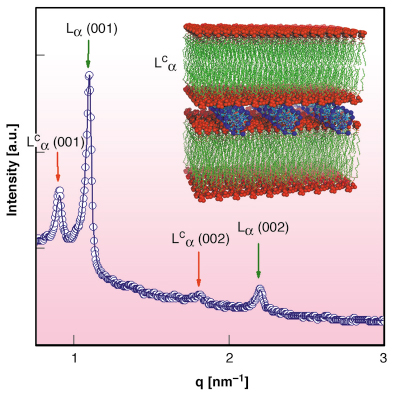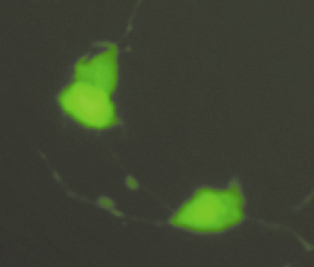- Home
- Users & Science
- Scientific Documentation
- ESRF Highlights
- ESRF Highlights 2006
- Soft Condensed Matter
- Structure and function of self-assembled liposome-DNA-metal complexes for gene transfer
Structure and function of self-assembled liposome-DNA-metal complexes for gene transfer
Gene therapy is an innovative technique for correcting the defective genes responsible for disease development. The goal is to achieve the transfer of extracellular genetic material into somatic cells and thereby provide therapeutic effects. Realisation of the full potential of gene therapy will depend in a major way on future developments of safe and efficient nonviral gene delivery (NGD) agents. Cationic lipid-DNA complexes [1] are presently the most diffuse DNA carriers in NGD applications and are extensively used in clinical trials. This is due to their ability to mimic natural viruses as chemical carriers of extracellular DNA across outer-cell and nuclear membranes (transfection). However, their transfection efficiency is still relatively low compared to that of viral vectors and they are also unstable in the presence of serum, which creates problems for in vivo applications. Furthermore, cationic liposomes are frequently toxic for the cells. These drawbacks are stimulating scientists to look for new synthetic gene vectors with a focus on understanding the structure-function relationships, where the ultimate goal is to enable a design-based approach to gene delivery.
We have recently started to study new ternary complexes formed by the self-assembled association of neutral liposomes, DNA and bivalent metal cations in water solution. Complexes composed of neutral lipids offer a promising alternative to cationic liposomes as they exhibit lower inherent cytotoxicity and longer circulation lifetimes. The supramolecular packing of these Liposome-DNA-Metal2+ complexes forms lyotropic liquid crystals that display rich phase and structural behaviour [2,3]. Recent measurements at ID02 have demonstrated the self-assembled formation of the lamellar L![]() phase in dioleoylphosphatidylcholine (DOPC)-DNA(plasmid)-Metal2+ complexes (Figure 42). This is a novel liquid crystal phase consisting of the multilamellar aggregation of stacked alternating lipid bilayers and DNA monolayers, which are mutually bound by the metal cations (inset of Figure 42). The process of self-aggregation is driven by the release of counter-ion entropy upon neutralisation of the DNA phosphate groups by the metal cations. The use of plasmid DNA instead of the more usual linear DNA is preferred because the native supercoiled conformation of the former is physiologically-active and hence the most promising for future therapeutic applications.
phase in dioleoylphosphatidylcholine (DOPC)-DNA(plasmid)-Metal2+ complexes (Figure 42). This is a novel liquid crystal phase consisting of the multilamellar aggregation of stacked alternating lipid bilayers and DNA monolayers, which are mutually bound by the metal cations (inset of Figure 42). The process of self-aggregation is driven by the release of counter-ion entropy upon neutralisation of the DNA phosphate groups by the metal cations. The use of plasmid DNA instead of the more usual linear DNA is preferred because the native supercoiled conformation of the former is physiologically-active and hence the most promising for future therapeutic applications.
 |
|
Fig. 42: The SAXS pattern of the DOPC-DNA-Mn2+ (4:3:12) solution mixture. Lc |
Preliminary tests were carried out to probe the transfection capacity of these systems. We have attempted in vitro transfections on mouse fibroblast cell lines (NIH 3T3), using DOPC-DNA(pGreenLantern1 plasmid)-Metal2+ as DNA vectors. The expression of the green fluorescent protein (GFP) that is codified by the plasmid once it is at the cell nucleus was analysed by means of fluorescence microscopy. Figure 43 shows the results obtained for DOPC-DNA-Ca2+ where the expression of the GFP is clearly apparent. Similar results were obtained for DOPC-DNA-Mn2+. These findings unquestionably demonstrate the capability of these complexes to transfect DNA.
 |
|
Fig. 43: Fluorescence micrograph of mouse fibroblast NIH 3T3 cell lines transfected with pGreenLantern1 DNA. The DNA was complexed to liposome of DOPC in presence of Ca2+. The photo was obtained using a standard FITC filter (excitation wavelength 488 nm with the objective at 10X). |
Encapsulation of the DNA in these ternary complexes combined with effective targeting and endosome-release technologies may represent an important alternative to current systemic gene approaches. Our results represent a first but nonetheless fundamental step towards the development of the materials and refinement of the procedures to achieve efficient and tissue-specific transfection for future gene therapy applications.
References
[1] J. O. Rädler, I. Koltover, T. Salditt, C. R. Safinya, Science 275, 810 (1997).
[2] O. Francescangeli, V. Staniç, L. Gobbi, P. Bruni, M. Iacussi, G. Tosi, S. Bernstorff, Phys. Rev. E 67, 011904 (2003).
[3] O. Francescangeli, M. Pisani, V. Staniç, P. Bruni, T. Weiss, Europhys. Lett. 67, 669 (2004).
Principal Publication and Authors
P. Bruni (a), M. Pisani (a), A. Amici (b), C. Marchini (b), M. Montani (b), and O. Francescangeli (c), Appl. Phys. Lett. 88, 073901 (2006).
(a) Dipartimento di Scienze dei Materiali e della Terra, Università Politecnica delle Marche, Ancona (Italy)
(b) Dipartimento di Biologia Molecolare, Cellulare e Animale, Università di Camerino (Italy)
(c) Dipartimento di Fisica e Ingegneria dei Materiali e del Territorio, Università Politecnica delle Marche, Ancona (Italy)



